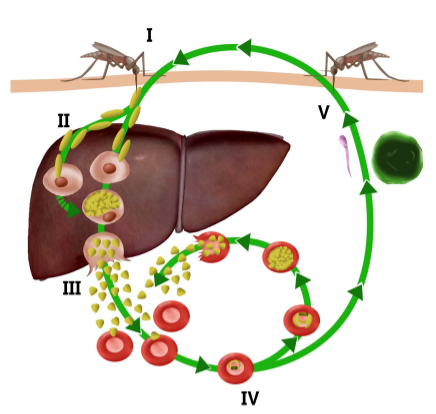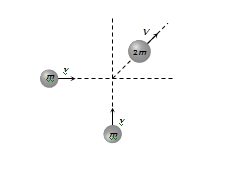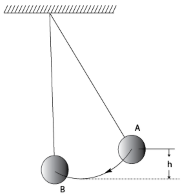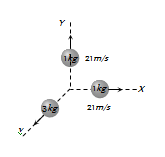12th Grade > Physics
COLLISIONS MCQs
Total Questions : 29
| Page 2 of 3 pages
Answer: Option D. -> e4h
:
D
The velocity attained after a fall through a height h is given by v2=2gh
Thus h∝v2 The velocity after first rebound is ev. Therefore, the height attained after first rebound = e2h. Velocity after second rebound is e2v. Hence the height attained after second rebounds is e4h. Thus the correct choice is (d).
:
D
The velocity attained after a fall through a height h is given by v2=2gh
Thus h∝v2 The velocity after first rebound is ev. Therefore, the height attained after first rebound = e2h. Velocity after second rebound is e2v. Hence the height attained after second rebounds is e4h. Thus the correct choice is (d).
Answer: Option B. -> v22g
:
B
In an elastic collision between two bodies of the same mass with one of them initially at rest, the movingbody is brought to rest and the other moves in the same direction with the same speed. Thus the ballwill come to rest and the bob of the pendulum acquires a speed v. At this speed, it will rise to height h givenby h=v22g. Hence the correct choice is (b).
:
B
In an elastic collision between two bodies of the same mass with one of them initially at rest, the movingbody is brought to rest and the other moves in the same direction with the same speed. Thus the ballwill come to rest and the bob of the pendulum acquires a speed v. At this speed, it will rise to height h givenby h=v22g. Hence the correct choice is (b).
Answer: Option D. -> - 2 mv
:
D
Change in momentum = m→v2−m→v1=−mv−mv=−2mv
:
D
Change in momentum = m→v2−m→v1=−mv−mv=−2mv
Question 14. Two balls marked 1 and 2 of the same mass m and a third ball marked 3 of mass M are arranged over a smooth horizontal surface as shown in Fig. Ball 1 moves with a velocity v1 towards balls 2 and 3. All collisions are assumed to be elastic. If M <m, the number of collisions between the balls will be


Answer: Option B. -> Two
:
B
The first collision will be between balls 1 and 2. Since both have the same mass, after the collision ball 1will come to rest and ball 2 will move with speed v1. This ball will collide with the stationary ball 3.After this second collision, let v2and v3 be the speeds of balls 2 and 3 respectively. Since the collisionsare elastic,v2 and v3 are given by (see Sec. 9)
v2=(m−Mm+M)v1 (i)
and v3=(2mm+M)v1 (ii)
If M < m,it follows from (i) and (ii) that v2 < v3 and both have the same direction.
Therefore, ball 2 cannot collide with ball 3 again. Hence there are only two collisions.
Thus the correct choice is (b).
:
B
The first collision will be between balls 1 and 2. Since both have the same mass, after the collision ball 1will come to rest and ball 2 will move with speed v1. This ball will collide with the stationary ball 3.After this second collision, let v2and v3 be the speeds of balls 2 and 3 respectively. Since the collisionsare elastic,v2 and v3 are given by (see Sec. 9)
v2=(m−Mm+M)v1 (i)
and v3=(2mm+M)v1 (ii)
If M < m,it follows from (i) and (ii) that v2 < v3 and both have the same direction.
Therefore, ball 2 cannot collide with ball 3 again. Hence there are only two collisions.
Thus the correct choice is (b).
Answer: Option A. -> (A−1A+1)2
:
A
Mass of neutron (m1)=1unit. Mass of nucleus (m2)=Aunits.
The velocity of the neutron after the collision is
v1=(m1−m2m1+m2)u=(1−A1+A)u
KE of neutron after collision = 12m1v21=12×1×(1−A1+A)2u2
KE of neutron before collision = 12mu2=12×1×u2=12u2.
Their ratio is (1−A1+A)2, which is choice (a)
:
A
Mass of neutron (m1)=1unit. Mass of nucleus (m2)=Aunits.
The velocity of the neutron after the collision is
v1=(m1−m2m1+m2)u=(1−A1+A)u
KE of neutron after collision = 12m1v21=12×1×(1−A1+A)2u2
KE of neutron before collision = 12mu2=12×1×u2=12u2.
Their ratio is (1−A1+A)2, which is choice (a)
Answer: Option A. -> Bob A comes to rest at B and bob B move to the left attaining a maximum height h.
:
A
Suppose the bob A acquires a velocity v on reaching the bob B. In a head-on elastic collision between two bodies of the same mass, the velocities are exchanged after the collision. Hence the bob A will come to rest at the lowermost position (occupied by B before collision) and the bob B will move to the left attaining a maximum height h. hence the correct choice is (a).
:
A
Suppose the bob A acquires a velocity v on reaching the bob B. In a head-on elastic collision between two bodies of the same mass, the velocities are exchanged after the collision. Hence the bob A will come to rest at the lowermost position (occupied by B before collision) and the bob B will move to the left attaining a maximum height h. hence the correct choice is (a).
Answer: Option D. -> v28g
:
D
In an inelastic collision, two bodies stick together. After the collision, the speed of the ball and the bob(sticking together) is v′=v2.
The height to which they will rise is given by v′=√2gh′orh′=v′22g=v28g
Hence the correct choice is (d).
:
D
In an inelastic collision, two bodies stick together. After the collision, the speed of the ball and the bob(sticking together) is v′=v2.
The height to which they will rise is given by v′=√2gh′orh′=v′22g=v28g
Hence the correct choice is (d).
Answer: Option B. -> 0
:
B
Coefficient of restitution is the ratio between Relative velocity of separation to Relative velocity of approach of colliding bodies.
In perfectly inelastic collision, the two bodies stay togethere after collision and hence the relative velocity of separation is zero.
Therefore, coefficient of restitution is zero.
:
B
Coefficient of restitution is the ratio between Relative velocity of separation to Relative velocity of approach of colliding bodies.
In perfectly inelastic collision, the two bodies stay togethere after collision and hence the relative velocity of separation is zero.
Therefore, coefficient of restitution is zero.



















